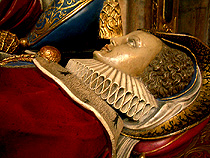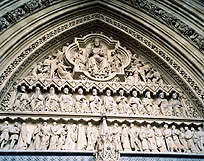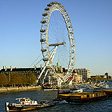WESTMINSTER
ABBEY – LONDON
Crypts, Coronations and Royal Weddings
 Westminster Abbey has been
the focal point of English
cultural history for a thousand
years and one of
the
most
visited tourist
sites in London. Almost a million visitors a year trundle across the poets
buried under its floor and ogle at the effigies of dead kings underneath. Westminster
Abbey should not be confused with Westminster Cathedral, the red
and cream parti-colored brick Victorian era church near Victoria
Station
Westminster Abbey has been
the focal point of English
cultural history for a thousand
years and one of
the
most
visited tourist
sites in London. Almost a million visitors a year trundle across the poets
buried under its floor and ogle at the effigies of dead kings underneath. Westminster
Abbey should not be confused with Westminster Cathedral, the red
and cream parti-colored brick Victorian era church near Victoria
Station
 Westminster Abbey was a cathedral for a brief time
of only ten years when Henry VIII dissolved the Catholic Church in
England.
He had many of the monastic abbeys destroyed, but Westminster as the
historic seat of kings was granted cathedral status to save it from
destruction. It went back to Catholicism under Queen Mary, but Elizabeth
I returned
it to the Anglican fold, now officially known as the Collegiate Church
of St Peter and a Royal Peculiar, meaning it is under the direct control
of the sovereign.
Westminster Abbey was a cathedral for a brief time
of only ten years when Henry VIII dissolved the Catholic Church in
England.
He had many of the monastic abbeys destroyed, but Westminster as the
historic seat of kings was granted cathedral status to save it from
destruction. It went back to Catholicism under Queen Mary, but Elizabeth
I returned
it to the Anglican fold, now officially known as the Collegiate Church
of St Peter and a Royal Peculiar, meaning it is under the direct control
of the sovereign.
 Westinster Abbey is located in the very heart of the city, across the
street from Big Ben and Parliament. First stone abbey was built in
the early Norman age,on the site of an early chruch erected where legend
said a fisherman had a vision of St Peter on the bank of the Thames
River.
The heavy Norman architecture was much replaced by the arches of the
Gothic style when it was rebuilt by Henry III, who thought it might
be a good place to be bured. Westminster Abbey is not known for its
scale,
far outdone by the great early Gothic and Norman cathedrals of York
(see York
Minster), Durham (see Durham
Cathedral) and Salisbury,
though it can
boast the highest of naves of its brethren in England.
Westinster Abbey is located in the very heart of the city, across the
street from Big Ben and Parliament. First stone abbey was built in
the early Norman age,on the site of an early chruch erected where legend
said a fisherman had a vision of St Peter on the bank of the Thames
River.
The heavy Norman architecture was much replaced by the arches of the
Gothic style when it was rebuilt by Henry III, who thought it might
be a good place to be bured. Westminster Abbey is not known for its
scale,
far outdone by the great early Gothic and Norman cathedrals of York
(see York
Minster), Durham (see Durham
Cathedral) and Salisbury,
though it can
boast the highest of naves of its brethren in England.
The tall elaborate
bell towers at the front of the abbey's west face were actually added
in the 18th Century, an early example of the Gothic Revival. Following
the third King Henry, the abbey became the burial site of kings and
queens from the Plantaganets to the Tudors. Oliver Cromwell was even
buried
there, though for only a short time before he was dug up and hung posthumously
on a gibbit outside the front door, his poll approval numbers having
dropped sharply after the return of the monarchy. Cromwell’s
severed decaying head was sold as a collector’s item a couple
of times before before finding its way to Sussex. His death mask can
be seen at
Warwick Castle (see Warwick Castle and the Tudors).
Coronation Throne
 Westminster Abbey is the traditional site of the coronations of the
sovereigns of England since 1308. The cornation chair, first used by
Edward I and
called King Edward’s Chair or St Edward’s Chair, though
neither the Scots nor the Welsh whom he subjegated (see Conwy
Castle North Wales) to
the English crown would likely consider him a saint. The magnificently
formal and uncomfortable looking wooden throne is now the model symbol
of monachy, though as viewed today, something is missing. The Stone
of Scone, the ancient symbol of Scottish rule was held under the chair
seat
for 700 years for the English kings to symbolically sit upon, now an
empty cubby hole. The stone is back in Scotland until it is to be returned,
temporarily, for the next coronation. At least they’ve promised
to return it.
Westminster Abbey is the traditional site of the coronations of the
sovereigns of England since 1308. The cornation chair, first used by
Edward I and
called King Edward’s Chair or St Edward’s Chair, though
neither the Scots nor the Welsh whom he subjegated (see Conwy
Castle North Wales) to
the English crown would likely consider him a saint. The magnificently
formal and uncomfortable looking wooden throne is now the model symbol
of monachy, though as viewed today, something is missing. The Stone
of Scone, the ancient symbol of Scottish rule was held under the chair
seat
for 700 years for the English kings to symbolically sit upon, now an
empty cubby hole. The stone is back in Scotland until it is to be returned,
temporarily, for the next coronation. At least they’ve promised
to return it.
The Museum and Crypt Effigies
 The
kings and queens effigies can be found below in the undercroft, the
oldest
part of the church, crowded with the stone efigies of
the greats
of England’s royal past, Edward III and Queen Philippa in stone
lying next to each other like a romantic love nest (see Woodstock and Mortimer's
Hole) surrounded by weepers in stone relief, King Henry
VII, Queen Elizabeth I, and King Charles II, who came after Cromwell
and
dealt
the Roundhead
the returned
favor of his father’s ignominious end. The last monarch buried
in the undercroft is Queen Anne. Along with the elegantly detailed
sculpted tomb effigies, other
artifacts on display include Henry V’s helmet and shield, panels
of medieval stained glass, Mary II’s coronation chair and replicas
of the English Coronation regalia.
The
kings and queens effigies can be found below in the undercroft, the
oldest
part of the church, crowded with the stone efigies of
the greats
of England’s royal past, Edward III and Queen Philippa in stone
lying next to each other like a romantic love nest (see Woodstock and Mortimer's
Hole) surrounded by weepers in stone relief, King Henry
VII, Queen Elizabeth I, and King Charles II, who came after Cromwell
and
dealt
the Roundhead
the returned
favor of his father’s ignominious end. The last monarch buried
in the undercroft is Queen Anne. Along with the elegantly detailed
sculpted tomb effigies, other
artifacts on display include Henry V’s helmet and shield, panels
of medieval stained glass, Mary II’s coronation chair and replicas
of the English Coronation regalia.
The Poets Corner
 Perhaps the most noted and fascinating attraction of Westminster
Abbey is its place as ceremonial cemetery. Not only kings and queens,
but
aristocrats and great figures of British cultural life, began to
be buried in the
abbey. Geoffrey Chaucer, the first great writer of the English language
was buried at the abbey where he lived in the late years of his life.
He was followed in 1599 by Edward Spenser, Elizabethan era author
of “The Faerie
Queen” (see Lismore
Castle Ireland) and a relative of Prince William on
his mother's side. The
area with stone markers in the floor came to be known as Poets Corner,
with
the graves of Dr Samuel Johnson, Alfred Lord Tennyson, Robert Browning
and Rudyard Kipling. The most famous of the dead poet’s society,
though not a poet, is Charles Dickens (see Charles
Dickens Museum). And not
buried, but with memorial plaques are honored, William Wordsworth (see Lake
District
Touring), Sir Walter
Scott, Lord Byron (see Byron's
Newstead Abbey), Percy Bysshe Shelley, Jane Austen,
the Bronte sisters and Henry James. Most notably missing, is England’s
greatest literary figure, William Shakespeare, which may or may not
be due to his not being
an actual real person – but
that they say is another story (see Shakespeare’s
Birthplace).
Speaking of literary mystery conspiracies - Westminster Abbey played
a part in the “Da Vinci Code”, with its elaborate tomb
of Sir Isaac Newton providing clues.
Perhaps the most noted and fascinating attraction of Westminster
Abbey is its place as ceremonial cemetery. Not only kings and queens,
but
aristocrats and great figures of British cultural life, began to
be buried in the
abbey. Geoffrey Chaucer, the first great writer of the English language
was buried at the abbey where he lived in the late years of his life.
He was followed in 1599 by Edward Spenser, Elizabethan era author
of “The Faerie
Queen” (see Lismore
Castle Ireland) and a relative of Prince William on
his mother's side. The
area with stone markers in the floor came to be known as Poets Corner,
with
the graves of Dr Samuel Johnson, Alfred Lord Tennyson, Robert Browning
and Rudyard Kipling. The most famous of the dead poet’s society,
though not a poet, is Charles Dickens (see Charles
Dickens Museum). And not
buried, but with memorial plaques are honored, William Wordsworth (see Lake
District
Touring), Sir Walter
Scott, Lord Byron (see Byron's
Newstead Abbey), Percy Bysshe Shelley, Jane Austen,
the Bronte sisters and Henry James. Most notably missing, is England’s
greatest literary figure, William Shakespeare, which may or may not
be due to his not being
an actual real person – but
that they say is another story (see Shakespeare’s
Birthplace).
Speaking of literary mystery conspiracies - Westminster Abbey played
a part in the “Da Vinci Code”, with its elaborate tomb
of Sir Isaac Newton providing clues.
Visiting Westminster Abbey London
 The abbey is open Monday, Tuesday, Thursday and Friday from 9.30am
to 4.30pm (last admission 3.30pm), Wednesday 9.30am to 7.00pm (last
admission
6.00pm) and Saturday 9.30am to 2.30pm (last admission 1.30pm).
It is only open for worship on Sundays with not for tourists. The
public
can go to services, but you don't get to wander around oggling
and the crypt
is closed. It is best to get and advance timed ticket as daily walk-up entries are limited. A number of guided
tours are offered at Westminster Abbey in addition
to the entrance charge. If you want to explore on your own an audio
guide
is free with admission. The nearest Underground tube stations are
Westminster and St James Park.
The abbey is open Monday, Tuesday, Thursday and Friday from 9.30am
to 4.30pm (last admission 3.30pm), Wednesday 9.30am to 7.00pm (last
admission
6.00pm) and Saturday 9.30am to 2.30pm (last admission 1.30pm).
It is only open for worship on Sundays with not for tourists. The
public
can go to services, but you don't get to wander around oggling
and the crypt
is closed. It is best to get and advance timed ticket as daily walk-up entries are limited. A number of guided
tours are offered at Westminster Abbey in addition
to the entrance charge. If you want to explore on your own an audio
guide
is free with admission. The nearest Underground tube stations are
Westminster and St James Park.
The most recent royal wedding to be held at Westminster Abbey of Prince
William and the Duchess Catherine, now Duke and Duchess of Cambridge,
was nearly as lavish as Charles and Diana,
but with some modern touches. Kate arrived
in
car
rather
than
the traditional royal princess Glass
Coach (see Royal
Mews Coaches), presumably a nod that she was a commoner,
but still Royal Coachmen and Footmen had jobs for the ride home
to the palace. © Bargain
Travel Europe
Find
best hotel and travel deals in London on
TripAdvisor
Web
Info
Westminster
Abbey
These articles are copyrighted and the sole property of Bargain Travel Europe and WLPV, LLC. and may not be copied or reprinted without permission.
See Also:
TOWER OF LONDON - CROWN JEWELS AND EXECUTIONS
MARY
SHELLEY TOURING SIGHTS IN LONDON
LONDON'S TOWER BRIDGE EXHIBITION


